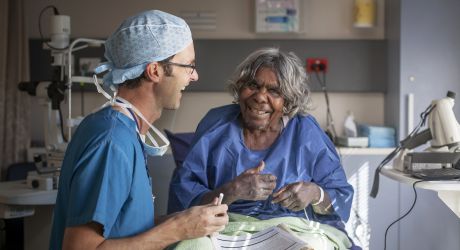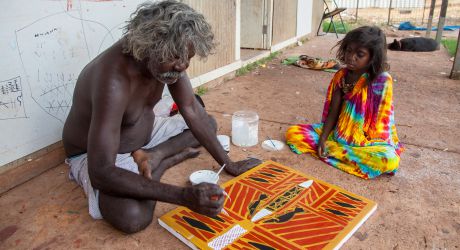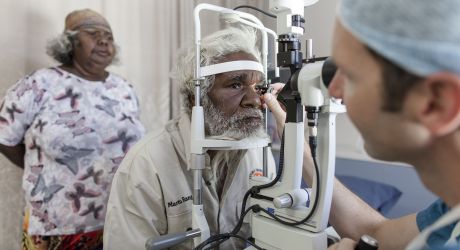Project Background
Currently Aboriginal and Torres Strait Islander adults are 6 times more likely than other Australians to go blind. But 94% of their vision loss is preventable or treatable and 35% of adults have never had an eye exam.
Since 2012, The Foundation’s Indigenous Australia Program (IAP) has been implementing integrated eye health programs in two regions of the Top End of the NT. These programming efforts, along with feedback received from regional stakeholders, have identified a number of gaps and issues which continue to affect rural and remote living Aboriginal and Torres Strait Islander peoples’ access to eye care services across the Top End.
These remote communities are only accessible by charter plane or long road trips covering difficult terrain, particularly in the wet season. This is often an insurmountable barrier for Aboriginal patients with the result that many live with avoidable blindness. The Foundation’s outreach visits reduce travel time and costs for patients, along with the associated stress of travelling into big cities to receive basic screening and treatment.

Key Project Outcomes
- 2,262 Aboriginal people screened during outreach visits to 33 remote and under serviced communities in the Top End of the Northern Territory.
- 57% increase in number of Aboriginal and Torres Strait Is-lander people added to elective surgery waitlists at Darwin, Katherine and Gove Hospitals.
- 1 Indigenous Liaison Officer, 1 ophthalmology fellow and 1 outreach ophthalmology coordinator employed.
- Significantly reduced the outpatient ophthalmology waitlists at the Katherine and Gove Hospitals
- Secured additional eye equipment for Katherine, Gove and Darwin Hospitals to improve the patient pathway, diagnosis, treatment and surgery outputs.
- Successfully lobbied the Northern Territory Department of Health to include $4.6 million in the 2016 budget for improvement in eye health, including an upgrade of the Ophthalmology Department and public eye clinic at the Royal Darwin Hospital.
- Advocated for the inclusion of service coordination in the Australian Government's Aboriginal and Torres Strait Islander eye health budget.
- Secured additional Australian Government funding for coordination to improve the delivery of eye care services for all states and territories

Indigenous artist Peter Datjing Burrarrwanga. Photo: Daniel Jesus Vignolli
Case Study: Peter Datjing Burrarrwanga
Through support of this project, you have helped restore sight to many Aboriginal and Torres Strait Islander people living in remote communities across the Top End. For Peter Datjing Burarrwanga (pictured), you helped restore sight to a Gumatj leader. Now he can continue to actively fulfil his responsibilities to his family, his clan and Gumatj people across East Arnhem Land in the NT.
Datjing is a man of many talents. A proud father and grandfather, a cere-monial leader and song man, renowned artist, a well-respected hunter, teacher and musician; he has a crucial role in maintaining Gumatj law and culture. And through his exquisite and detailed paintings he proudly teaches the next generation about culture.

What next?
There is always more work to be done as we strive to end avoidable blindness. The Foundation relies on the continued support of our generous donors to achieve Fred’s dream of a world where no one is needlessly blind.
In 2016, The Foundation’s Top End Outreach Ophthalmology Re-sources Project will:
- Conduct outreach ophthalmology services in remote communities in the Top End of the NT
- Improve awareness and education of eye health and available services among Aboriginal and Torres Strait Islanders people living in remote communities across the Top End
- Continue to support the employment of an Ophthalmology Fellow, an Indigenous Liaison Officer and an Outreach Ophthalmology Coordinator
- Advocate to governments for sustainable investment in eye care
Can I visit this project?
Interested donors should contact The Foundation directly.

The project aim:
We focus on providing high quality, accessible and culturally appropriate eye services to remote and under-serviced Aboriginal and Torres Strait Islander communities in Australia. We invest in eye care programs across Australia to;
- Address ophthalmology workforce shortages
- Coordinate and improve outreach eye services
- Improve patient experience and integrate eye care in the primary health care system
- Build strategic alliances and advocate to government for sustained investment in eye care
Project objectives:
- Increase the quantity of eye services and improve the quality and delivery of eye care to Aboriginal and Torres Strait Islanders living in the Top End through improved coordination, integration and efficiency of outreach services; increased access to assessment and surgical referral services; and improved understanding of community need and demand for eye services.
- Increase access to and uptake of comprehensive culturally appropriate eye care services by Aboriginal and Torres Strait Islander patients in the Top End by increasing support for eye care patients and their families throughout the patient journey; and improving awareness and education of eye conditions.Raise the profile of avoidable blindness as a public health issue and build evidence and support for a sustainable outreach ophthalmology service model that can be applied to the Top End and other regions of the NT.

Background on this issue:
Fred was a fierce defender of human rights. He fought for what he believed in, especially when it came to the health of Aboriginal and Torres Strait Islander Australians.
Currently Aboriginal and Torres Strait Islander adults are 6 times more likely than other Australians to go blind. But 94% of their vision loss is preventable or treatable and 35% of adults have never had an eye exam.
Since 2012, The Foundation’s Indigenous Australia Program (IAP) has been implementing integrated eye health programs in two regions of the Top End of the NT. These programming efforts, along with feedback received from regional stakeholders, have identified a number of gaps and issues which continue to affect rural and remote living Aboriginal and Torres Strait Islander peoples’ access to eye care services across the Top End.
The TEOOR Project seeks to address these issues through the provision of a resourced outreach ophthalmology team. This Project will increase Royal Darwin Hospital’s capacity to deliver the expanded outreach ophthalmology services secured through the Rural Health Outreach Fund and administered by Specialist Outreach Northern Territory (SONT).
Project partners
The two key partners with The Foundation are the Northern Territory Government’s Top End Health Service and the Royal Darwin Hospital Eye Clinic. Other partners include the Rural Health Outreach Fund and the Specialist Outreach Northern Territory.
How was it this funded?
Thanks to hundreds of tiny donations from these online businesses and their customers.
- Travel Insurance Direct AU
- Travel Insurance Direct NZ
- ***Tourism Holdings Limited

The Fred Hollows Foundation is an international development organisation working towards eliminating avoidable blindness and improving Indigenous Australian health. We are inspired by Professor Fred Hollows, a humanitarian, eye surgeon and social activist. Established in 1992, The Foundation continues in Fred’s footsteps and now works in more than 25 countries around the world and here in Australia. Working with in-country partners, we perform surgeries, deliver local training, provide equipment, educate about eye health and advocate for change.